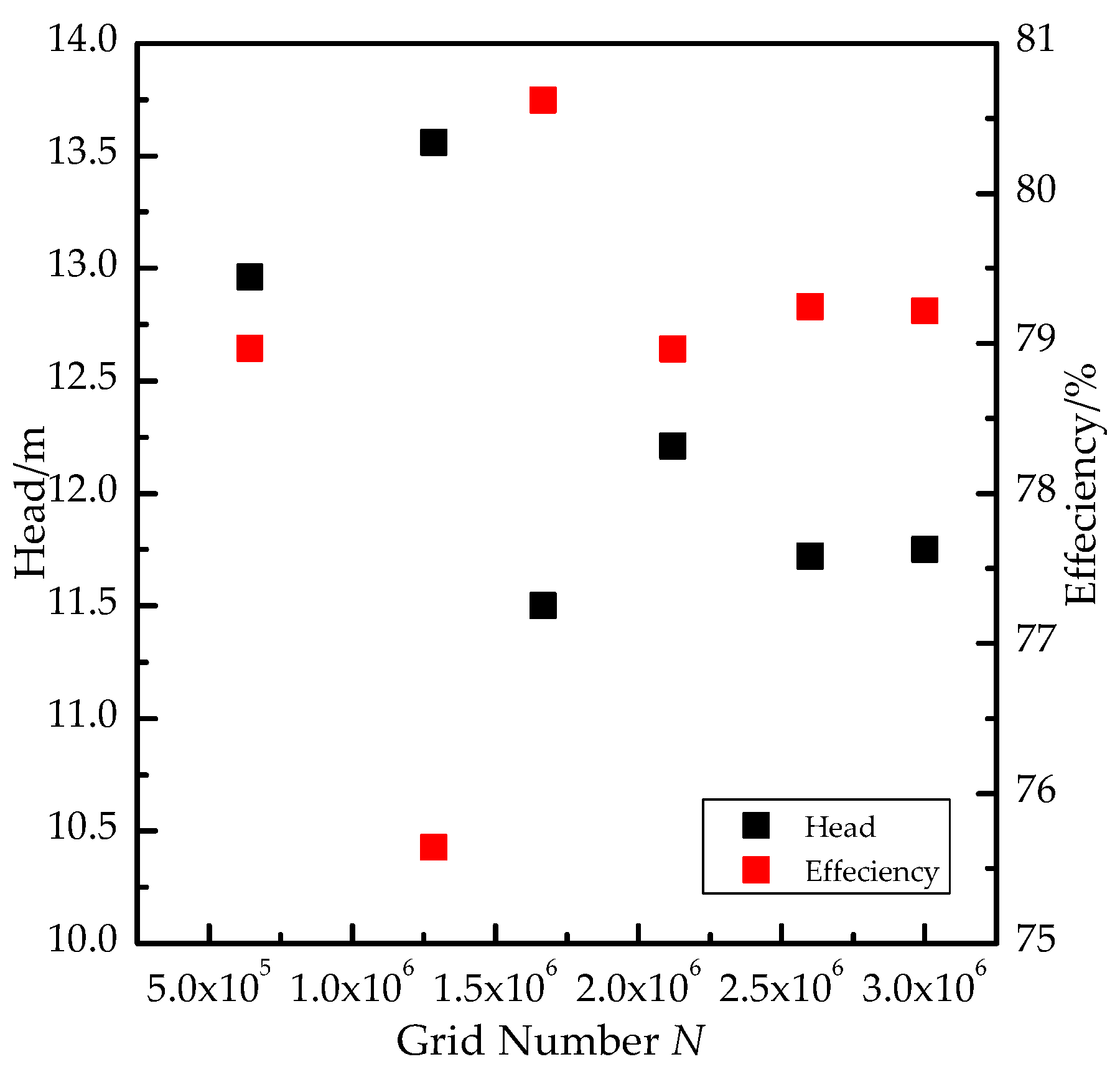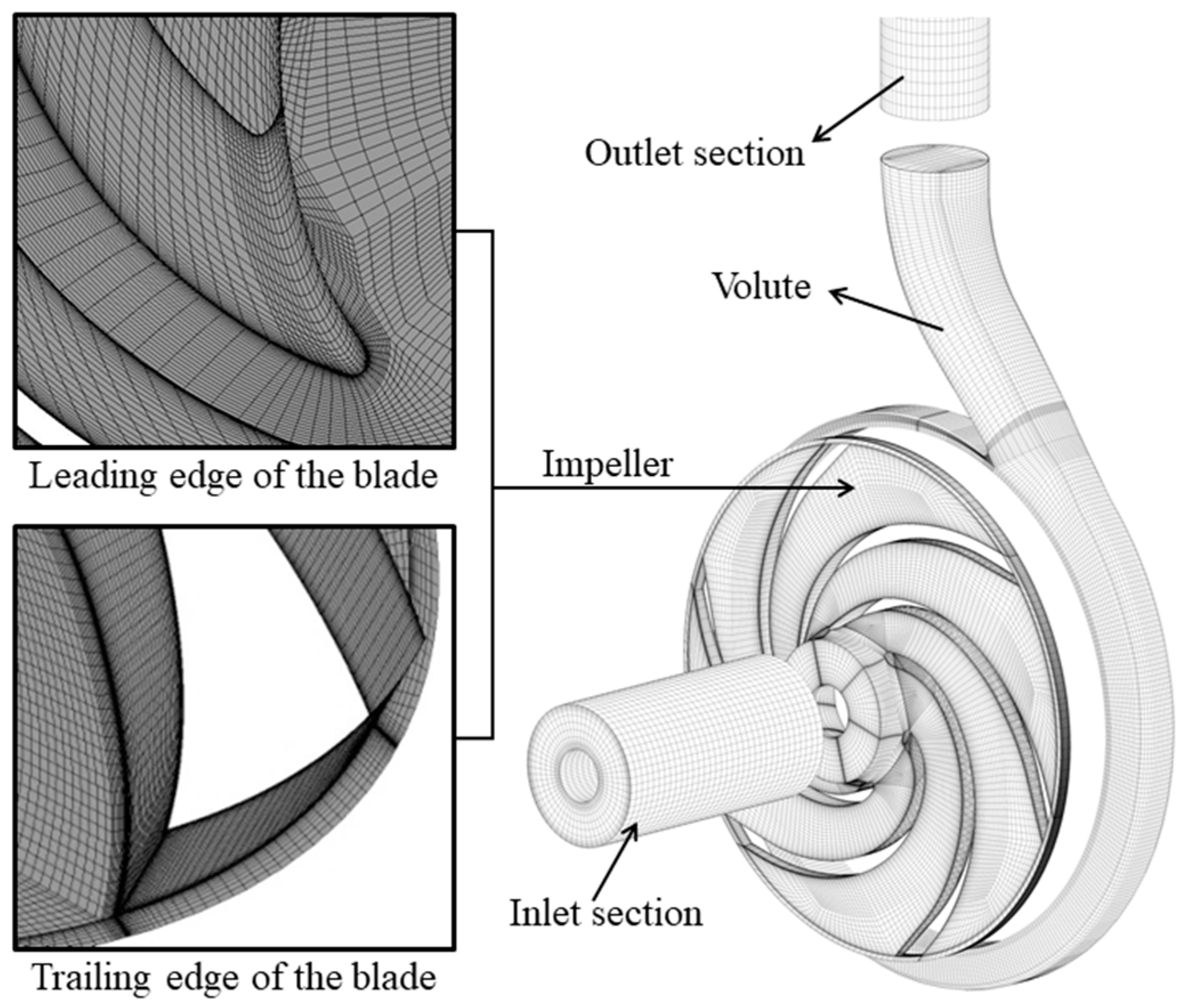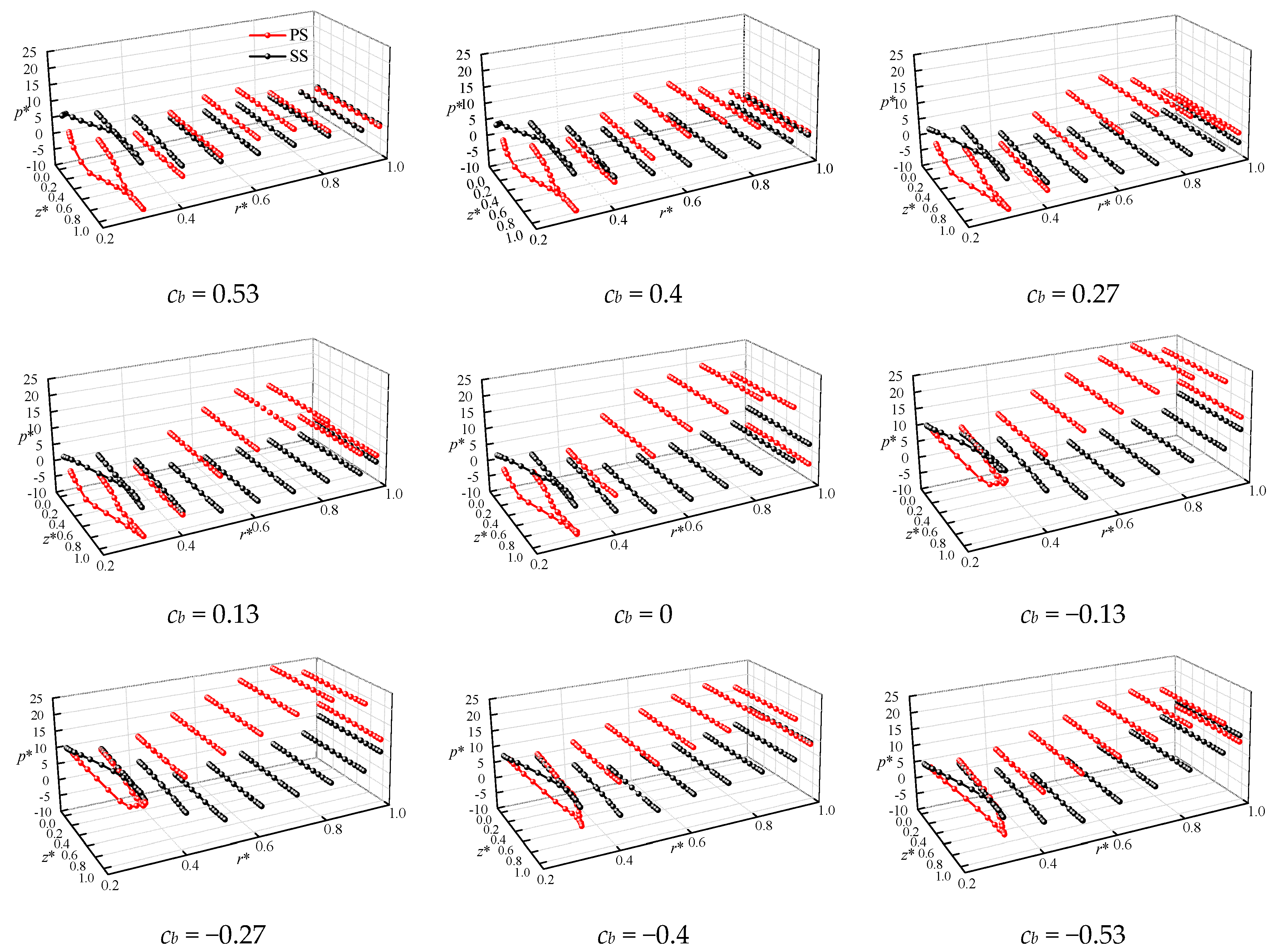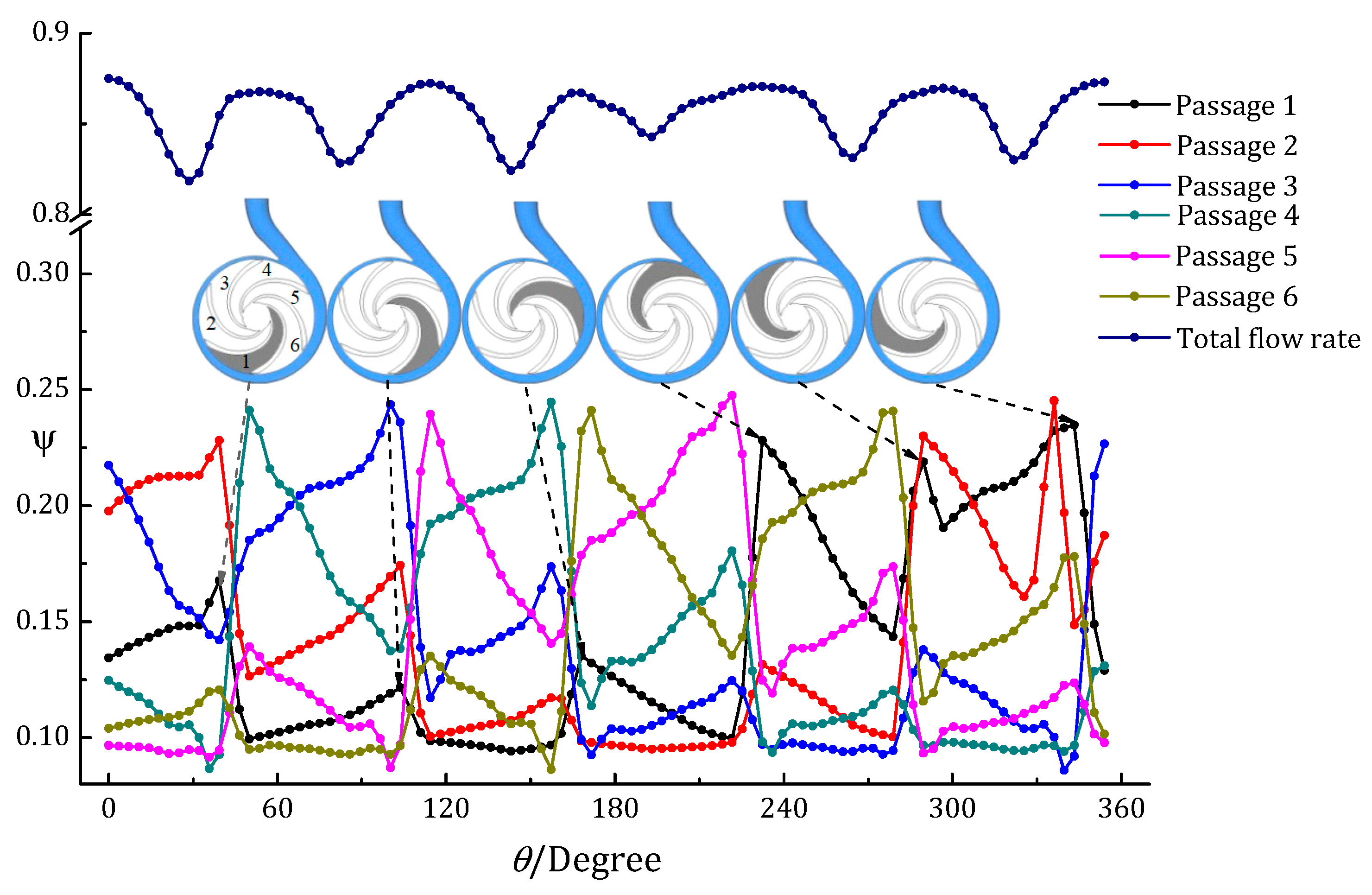Cavitating Flow in the Volute of a Centrifugal Pump at Flow Rates Above the Optimal Condition
Abstract
1. Introduction
2. Geometry and Parameters
3. Numerical Modeling
3.1. Three-Dimensional Model and Grids
3.2. Boundary Conditions
4. Hydraulic Tests of the Pump
5. Results Analysis and Discussion
5.1. Cavitation Clouds at the Tongue
5.2. Blade-Loading Distribution
6. Conclusions
Author Contributions
Funding
Institutional Review Board Statement
Informed Consent Statement
Data Availability Statement
Acknowledgments
Conflicts of Interest
References
- Brennen, C.E. Hydrodynamics of Pumps; Concepts ETI and Oxford University Press: Oxford, UK, 2011. [Google Scholar]
- Hofmann, M.; Stoffel, B.; Friedrichs, J. Similarities and geometrical effects on rotating cavitation in two scaled centrifugal pump. In Proceedings of the Fourth International Symposium on Cavitation, Pasadena, CA, USA, 20–23 June 2001. [Google Scholar]
- Murayama, M.; Yoshida, Y.; Tsujimoto, Y. Unsteady Tip Leakage Vortex Cavitation Originating from the Tip Clearance of an Oscillating Hydrofoil. ASME J. Fluids Eng. 2006, 128, 421–429. [Google Scholar] [CrossRef]
- Zan-Ao, H.U.; Wang, J.X. Effect of Blade Perforation on Centrifugal Pump Cavitation Characteristics. J. Eng. Therm. Energy Power. 2018, 33, 10. [Google Scholar]
- Liu, H. Effects of Blade Number on Characteristics of Centrifugal Pumps. Chin. J. Mech. Eng. 2010, 6, 742–747. [Google Scholar] [CrossRef]
- Philippe, D.; Tomoyoshi, O. Cavitating Flow Calculations in Industry. Int. J. Rotating Mach. 2003, 9, 163–170. [Google Scholar]
- Hattori, S.; Kishimoto, M. Prediction of cavitation erosion on stainless steel components in centrifugal pumps. Wear 2007, 265, 1870–1874. [Google Scholar] [CrossRef]
- Zhang, D.S.; Shi, W.D. Numerical and experimental investigation of tip leakage vortex trajectory and dynamics in an axial flow pump. Comput. Fluids. 2015, 112, 61–71. [Google Scholar] [CrossRef]
- Kim, K.H.; Franc, J.P. Advanced Experimental and Numerical Techniques for Cavitation Erosion Prediction; Springer: Dordrecht, The Netherlands, 2014. [Google Scholar]
- Maklakov, D. Cavitation flow past an arbitrarily-shaped airfoi. Fluid Dyn. 1995, 30, 713–716. [Google Scholar] [CrossRef]
- Fu, Q.; Zhang, F.; Zhu, R.S. A systematic investigation on flow characteristics of impeller passage in a nuclear centrifugal pump under cavitation state. Ann. Nucl. Energy 2016, 97, 190–197. [Google Scholar] [CrossRef]
- Dumitrescu, H.; Cardos, V. Analysis of leading-edge separation bubbles on rotating blades. J. Aircr. 2010, 47, 1815–1819. [Google Scholar] [CrossRef]
- Rudolf, B.; Bernd, S.; Matevz, D. Unsteady cavitation at the tongue of the volute of a centrifugal pump. J. Fluids Eng. 2010, 132, 6. [Google Scholar]
- Al-Obaidi, A.R. Investigation of effect of pump rotational speed on performance and detection of cavitation within a centrifugal pump using vibration analysis. Heliyon 2019, 5, e01910. [Google Scholar] [CrossRef]
- Wang, C.; Zhang, Y.X.; Yuan, Z.Y. Development and application of the entropy production diagnostic model to the cavitation flow of a pump-turbine in pump mode. Renew. Energy 2020, 154, 774–785. [Google Scholar] [CrossRef]
- Dular, M.; Bachert, R.; Sirok, B. Transient simulation, visualization and PIV-LIF measurements of the cavitation on different hydrofoil configurations. Stroj. Vestn. 2005, 51, 13–27. [Google Scholar]
- Qiu, C.; Huang, Q.; Pan, G. Numerical simulation of hydrodynamic and cavitation performance of pumpjet propulsor with different tip clearances in oblique flow. Ocean. Eng. 2020, 209, 107285. [Google Scholar] [CrossRef]
- Xia, C.Z.; Cheng, L.; Shang, Y.N. Numerical simulation on the cavitation of waterjet propulsion pump. IOP Conf. Ser. Mater. Sci. Eng. 2016, 129, 012011. [Google Scholar] [CrossRef]
- Yang, Y.; Zhou, L.; Hang, J. Energy characteristics and optimal design of diffuser meridian in an electrical submersible pump. Renew. Energy 2021, 167, 718–727. [Google Scholar] [CrossRef]
- Yang, Y.; Zhou, L.; Shi, W. Interstage difference of pressure pulsation in a three-stage electrical submersible pump. J. Pet. Sci. Eng. 2020, 196, 107653. [Google Scholar] [CrossRef]
- Yang, Y.; Zhou, L.; Zhou, H. Optimal Design of Slit Impeller for Low Specific Speed Centrifugal Pump Based on Orthogonal Test. J. Mar. Sci. Eng. 2021, 9, 121. [Google Scholar] [CrossRef]
- Jiang, J.; Li, Y.H.; Pei, C.Y. Cavitation performance of high-speed centrifugal pump with annular jet and inducer at different temperatures and void fractions. J. Hydrodyn. 2019, 31, 93–101. [Google Scholar] [CrossRef]
- Jain, S.V. Experimental Investigations of Cavitation Characteristics of Pump Running in Turbine Mode. J. Energy Eng. 2017, 143, 1–12. [Google Scholar] [CrossRef]
- Wang, J.; Wang, Y.; Liu, H.; Huang, H. An improved turbulence model for predicting unsteady cavitating flows in centrifugal pump. Int. J. Numer. Methods Heat Fluid Flow 2015, 25, 1198–1213. [Google Scholar] [CrossRef]
- Liu, J.T.; Liu, S.H.; Wu, Y.L. Numerical investigation of the hump characteristic of a pump–turbine based on an improved cavitation model. Comput. Fluids 2012, 68, 105–111. [Google Scholar] [CrossRef]
- Hu, Q.; Yang, Y.; Cao, W. Computational analysis of cavitation at the tongue of the volute of a centrifugal pump at overload conditions. Adv. Prod. Eng. Manag. 2020, 15, 295–306. [Google Scholar] [CrossRef]
- Zwart, P.J.; Gerber, A.G.; Belamri, T. A two-phase flow model for predicting cavitation dynamics. In Proceedings of the Fifth International Conference on Multiphase Flow, Yokohama, Japan, 30 May–3 June 2004. [Google Scholar]








| Optimal Flow Rate Qd (m3/h) | 10 |
| Designed Head H (m) | 11 |
| Rated Revolution n (r/min) | 1450 |
| Rated Power P (kW) | 3 |
| Impeller Outer Diameter D2 (mm) | 192 |
| Impeller Inlet Diameter D1 (mm) | 54 |
| Impeller Hub Diameter dh (mm) | 20 |
| Impeller Outlet Width b2 (mm) | 5 |
| Blade Outlet Angle β2 | 27.5 |
| Notation | Note | Q (m3/h) | H (m) |
|---|---|---|---|
| Test number | 1 | 15.28 | 10.75 |
| 2 | 15.29 | 10.79 | |
| 3 | 15.23 | 10.86 | |
| 4 | 15.25 | 10.96 | |
| 5 | 15.27 | 10.97 | |
| 6 | 15.10 | 10.96 | |
| 7 | 15.14 | 11.00 | |
| 8 | 15.19 | 10.97 | |
| Random uncertainty | Average value | 15.219 | 10.908 |
| Standard deviation | 0.0694 | 0.0947 | |
| eR (%) | 0.379 | 0.723 | |
| System uncertainty | Measurement accuracy (%) | 0.25 | 0.2 |
| eS (%) | 0.144 | 0.115 | |
| Overall uncertainty | e (%) | 0.405 | 0.741 |
Publisher’s Note: MDPI stays neutral with regard to jurisdictional claims in published maps and institutional affiliations. |
© 2021 by the authors. Licensee MDPI, Basel, Switzerland. This article is an open access article distributed under the terms and conditions of the Creative Commons Attribution (CC BY) license (https://creativecommons.org/licenses/by/4.0/).
Share and Cite
Qixiang, H.; Yang, Y.; Weidong, S.; Weidong, C.; Yansheng, S. Cavitating Flow in the Volute of a Centrifugal Pump at Flow Rates Above the Optimal Condition. J. Mar. Sci. Eng. 2021, 9, 446. https://doi.org/10.3390/jmse9040446
Qixiang H, Yang Y, Weidong S, Weidong C, Yansheng S. Cavitating Flow in the Volute of a Centrifugal Pump at Flow Rates Above the Optimal Condition. Journal of Marine Science and Engineering. 2021; 9(4):446. https://doi.org/10.3390/jmse9040446
Chicago/Turabian StyleQixiang, Hu, Yang Yang, Shi Weidong, Cao Weidong, and Shi Yansheng. 2021. "Cavitating Flow in the Volute of a Centrifugal Pump at Flow Rates Above the Optimal Condition" Journal of Marine Science and Engineering 9, no. 4: 446. https://doi.org/10.3390/jmse9040446
APA StyleQixiang, H., Yang, Y., Weidong, S., Weidong, C., & Yansheng, S. (2021). Cavitating Flow in the Volute of a Centrifugal Pump at Flow Rates Above the Optimal Condition. Journal of Marine Science and Engineering, 9(4), 446. https://doi.org/10.3390/jmse9040446








